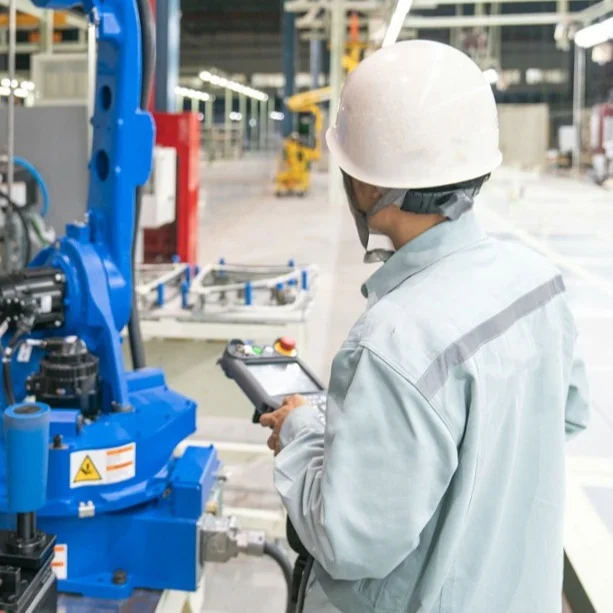Mention the term “connected factory,” and many people who work in modern manufacturing will assume their workplace is already connected, with automated processes and robots performing many production tasks. From an IoT perspective, however, the term can also refer to another layer of connectivity, one which represents a second level of improvement in the production process.
A connected factory, in IoT terms, is one that allows more elements of production to be measured and tracked in order to inform process improvements, monitor assets for location and preventative maintenance, locate raw materials, and assess other metrics of the production cycle.
Work-in-Progress Tracking
In many factories, work-in-progress tracking already takes place through manual tracking methods, generally with barcode scanning. In these systems, as manufacturing components move from one workstation to the next, workers scan a “traveler” document that accompanies each component and records when each process is completed. This system works well most of the time; the problems occur when workers forget or fail to scan. At that point, there’s no way to locate the item other than conducting a physical search to track it down. Some high-tech industries, such as aerospace, have teams of “expediters” working each shift, whose only job is to hunt down missing parts so that work can move forward.
In situations like these, a real-time location system (RTLS) like the AirFinder tracking system, can eliminate both lost items and the need for a team of expediters.
The AirFinder system is also useful for cases where a part or assembly needs to be removed from the production line for reworking and falls out of the normal workflow. Items become harder to track when they move into a different production center, and there can also be time-loss issues. For example, if technicians are waiting for a part that has been scanned for reworking, but they get no real-time alert when the part arrives at the rework center, it may go unnoticed for several hours after it arrives until someone asks or thinks about it.
Real-time location tracking with the AirFinder system can eliminate these types of bottlenecks, both by pinpointing location and with automated alerts, notifying technicians that an item needing rework has arrived. Adding an automatic tracking system solves issues that cannot be addressed with scanning or other manual tracking methods.
Raw Material Tracking and Monitoring in the Connected Factory
For many industries, real-time tracking of materials is not imperative. Barcode scanning is already widely used for tracking all types of raw materials, and for non-perishable materials it generally works well. (Though it suffers the same pitfalls as work-in-progress tracking via scanning—materials can be “lost” if a worker forgets to perform a scan).
With perishable raw materials such as food or drug ingredients, however, the limitations of barcode scanning become more of an issue. While scanning creates an accurate picture of the types and quantities of materials on hand, it is less useful for managing inventory rotation, and not at all useful for monitoring storage conditions.
In the connected factory, location tags on raw materials allow workers to easily locate perishable materials that have been in stock for the longest period of time. This minimizes waste by ensuring that materials are used before they expire or spoil.
The AirFinder system can also monitor storage conditions to protect perishable materials from light, temperature, shock, or humidity that could, in some cases, be damaging. For example, a tag programmed to monitor a vaccine that requires a specific temperature range to remain potent will send an alert if temperatures fall below or rise above that range. The alert allows workers to immediately address the problem and prevent spoilage of the material.
End-to-end real time tracking with AirFinder is also useful for managing work flow in manufacturing processes that assemble components produced by other suppliers. Components are tracked while in transit to better estimate when they will arrive and the work cycle can be adjusted accordingly. Once on site, location tags allow components to be located in storage and tracked through the factory.
Tracking Workers in the Connected Factory
Of all of the types of tracking that can take place in the connected factory, tracking people is the only one that tends to spark debate, for the simple reason that people don’t like to be tracked. But there are a number of good reasons for tracking workers in a manufacturing facility. These include safety, security, space utilization, and performance.
In terms of safety, manufacturers have both a financial and human interest in protecting the lives and health of their workers. Worker tracking can monitor traffic in areas where hazardous materials are stored or used, and send an alert if a worker who is not properly trained in managing the risks of handling those materials enters the area.
Similarly, worker tracking can be used for security purposes, restricting access to only those employees engaged in work on sensitive projects. A good example would be in arms manufacture, where limited access needs to be enforced for ITAR (International Traffic in Arms Regulations) compliance. In this case, workers’ tags will send an alert if someone is an area they are not authorized to enter.
Worker tracking is also useful for companies that want to gather data on space utilization. In this case, tracking can be anonymous—that is, bodies are being tracked, rather than individuals. The goal is to determine how space can be used more efficiently, by revealing which areas are most heavily used and would benefit from a larger footprint, versus areas that are underutilized and may require less space than is currently allotted.
Performance or effectiveness tracking is the type most likely to generate pushback, because it is the one that feels the most invasive to workers. It can make people feel like they are constantly being watched, and, in a sense, they are. Though the tracking tag isn’t literally putting eyes on the worker and recording every action, it is gathering data on how workers are spending their time by recording where they are and for how long. Although performance tracking may cause discomfort for some workers, many companies’ HR departments are interested in collecting this type of data, both for the information it can provide to improve work processes, and because of the belief that workers are more focused on their work and more productive if they know they are being tracked.
Monitoring Equipment in the Connected Factory
Many existing factory automation systems operate in closed cloud networks. These OT (operational technology) networks accumulate a large amount of data that is not easily accessible outside the network, but may offer valuable insight into processes if it can be collected and analyzed. This particular aspect of the connected factory promotes the use of data from all aspects of a production system to guide efficiency and productivity improvements.
One example of how the data collected from OT networks can be used is “predictive maintenance” or PdM. PdM is a burgeoning market, predicted to grow to 11 billion dollars by 2022, as more manufacturers adopt PdM systems to take advantage of the benefits they offer.
For example, if a particular piece of machinery is using 20 percent more power than it was using a month ago, it may be an indication that maintenance or repair is needed. Continuous analysis of the data compiled on the OT network can highlight impending problems so that maintenance or repairs can be done before a breakdown occurs, averting disruption of production. PdM systems can also identify exactly where the breakdown has occurred in a malfunctioning machine, eliminating guesswork about what needs to be done to bring the machine back online. This minimizes downtime and the costs associated with repair and disruption of the workflow.
Are you ready to take connectivity to the next level in your manufacturing facility?
The various tracking and monitoring systems used in connected factories offer businesses the potential to improve every element of their production cycle. Contact Link Labs today to learn more about AirFinder, the affordable and easy-to-implement solution for achieving next-level connectivity in your factory.




